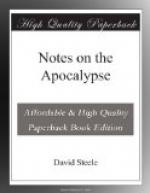Constantine, however, was more of a politician than divine. To the student of history he will appear in many respects a striking prototype of William Prince of Orange, who on a less extended scale answers as an antitype in the latter part of the seventeenth century. Neither of them exemplified in their lives the “power of godliness”. Like Charles the Second, they did not consider primitive apostolic Christianity “a religion for a gentleman.” Constantine combined in his character the properties of the lion and the fox. He was crafty and ambitious. Usurping the prerogatives of Zion’s King, he assumed a blasphemous supremacy over the church, and proceeded to model her external polity after the example of the empire. Among the Christian ministry, he found mercenary spirits who pandered to his ambition,—“having his person in admiration because of advantage.” Advancing these to positions of opulence and splendor, he could certainly rely upon them to support him in his schemes of aggrandizement. Thus the mystery of iniquity, whose working Paul discovered in his time, was nurtured to its full development in Heaven’s appointed time. (2 Thess. ii. 7, etc.) If on such occasions mighty kings and valiant generals are stricken with dismay, what shall be the terror of all the impenitent enemies of the Lord and his Anointed when the heavens and the earth shall pass away and leave them without these imaginary hiding places from “the wrath of the Lamb!”
CHAPTER VII.
The scenes portrayed by varied symbols in this chapter, are by some considered as a continuation of the sixth seal. We think they may with more propriety be viewed as relating to the events under the four which precede; while they are obviously preparatory to the opening of the last seal in the next chapter.
1. And after these things I saw four angels standing on the four corners of the earth, holding the four winds of the earth, that the wind should not blow on the earth, nor on the sea, nor on any tree.
V. 1. The “four angels” represent the instruments of providence. The “four corners of the earth” intend all nations of the world, as then known in geography. (Ch. xx. 8, 9.) The “holding of the winds” is emblematical of the tranquillity consequent upon the accession of Constantine to the imperial throne,—the temporary cessation of desolating wars and persecutions,—the “rest” for which the martyrs prayed. “Thou calledst in trouble, and I delivered thee.” (Ps. lxxxi. 7.)




